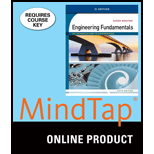
Find the motor which is recommended to purchase based on the given information.
Answer to Problem 14P
Bases on the given information, the Motor – Y is recommended to purchase.
Explanation of Solution
Given data:
The power of the Motor – X
The pump is expected to run
Average electricity cost of the motor is
The number of years for the life of Motor – X
Initial cost for Motor – X and Motor – Y is
Operating point efficiency of the Motor – X
Maintenance cost of Motor – X and Motor – Y is
Calculation:
Assume the interest rate as
Case (i): For Motor - X
Initially calculate the operating cost for the Motor- X using the power, efficiency at the operating point, electricity cost and pump life time.
Convert the electricity cost from cent per kWh to dollar per kWh using the following relationship.
Therefore,
The average electricity cost of the motor is
Formula to calculate the operating cost of the Motor – X is,
Here,
Substitute
Therefore, the present worth of the Motor – X can be calculated using the following expression:
Here,
Substitute
Refer to the Table 20.9 in the textbook, the value for
Substitute
Hence, the present worth of the Motor – X is
Case (ii): For Motor - Y
Initially calculate the operating cost for the Motor- Y using the power, efficiency at the operating point, electricity cost and pump life time.
Convert the electricity cost from cent to dollar using the following relationship.
Therefore,
The average electricity cost of the motor is
Formula to calculate the operating cost of the Motor – Y is,
Here,
Substitute
Therefore, the present worth of the Motor – Y can be calculated using the following expression:
Here,
Substitute
Refer to the Table 20.9 in the textbook, the value for
Substitute
Hence, the present worth of the Motor – Y is
Compare the equations (4) and (8), from the analysis it is clear that the Motor – Y provides the least present value than the Motor – X.
Therefore, the Motor – Y should be recommended to purchase.
Conclusion:
Thus, the Motor – Y should be recommended to purchase.
Want to see more full solutions like this?
Chapter 20 Solutions
MindTap Engineering, 2 terms (12 months) Printed Access Card for Moaveni's Engineering Fundamentals, SI Edition, 5th
- Given the table below, calculate the total cost for all the items needed. What would be the total estimate with a 15 percent contingency? If a 10 percent reserve is added, what would be the total estimate? Items Cost/Unit Quantity Wheel $500 12 Bearing $25 400 Clamp $5 40 Nozzle $7 30 Nut $2 40 Caster $55 120arrow_forwardYou have just moved to a new country to take up a two-year assignment. You need to buy a car and are deciding between a new one that costs $20,000 and a three year-old one that costs $9,000. The used car has an odometer reading of 25,000 miles. You have $10,000 in savings, and can borrow the rest from your company, repaying them 110% after two years. The value of the new car will depreciate by 50% in two years, while that of the used car will depreciate by one-third. What should you do? Use the seven-step procedure to analyze your situation. Attached is the photo of the seven step procedure.arrow_forwardusing the following information:When an object goes on sale, the savings can be found bymultiplying the portion taken off by the price of the object.23. A heating supply dealer has taken 1⁄5 off the price of an acetylene torch. If theprice was $233.57, what is the savings for buying the torch today?arrow_forward
- You have been asked to estimate the per unit selling price of a new line of clothing. Pertinent data are given as follows. Past experience has shown that an 80% learning curve applies to the labor required for producing these items. The time to complete the first item has been estimated to be 1.76 hours. Use the estimated time to complete the 50th item as your standard time for the purpose of estimating the unit selling price.arrow_forwardSolve the question below. Show your complete solution.arrow_forwardMr. Cruz decided to flipped a coin five times, what is the probability of getting at most 3 tails? Show your complete and detailed solution. Thank you.arrow_forward
- Calculate the problem below and show your complete solutions.arrow_forwardIrish went to her father's farm. Her father has ducks and cows on his farm. she asked him how many ducks and how many cows. He told her that his animals had 26 heads and 68 legs, and from that data,she could calculate the number of ducks and the number of cows. If you were Irish, how will you solve the situation?arrow_forwardIf $197 is deposited in a savings account at the beginning of each year for 12 years and the account draws interest at 7% per year, compounded annually, the value of the account at the end of 12 years will be most nearly. Express your answer in whole number. Correct Answer: 3,771 ± 1arrow_forward
- The demand function for a product is modeled by p(x) = 50e^-0.0000125x where p is the price per unit in dollars and x is the number of units. What price will yield a maximum revenue? (Hint: Revenue= (Price) x (No. of Units))arrow_forwardShow complete solution and 3 decimal places for final answer. Asap thanks! Ill rate your solutionarrow_forwardSolve step by step within 5 minutesarrow_forward
 Engineering Fundamentals: An Introduction to Engi...Civil EngineeringISBN:9781305084766Author:Saeed MoaveniPublisher:Cengage Learning
Engineering Fundamentals: An Introduction to Engi...Civil EngineeringISBN:9781305084766Author:Saeed MoaveniPublisher:Cengage Learning Traffic and Highway EngineeringCivil EngineeringISBN:9781305156241Author:Garber, Nicholas J.Publisher:Cengage Learning
Traffic and Highway EngineeringCivil EngineeringISBN:9781305156241Author:Garber, Nicholas J.Publisher:Cengage Learning

